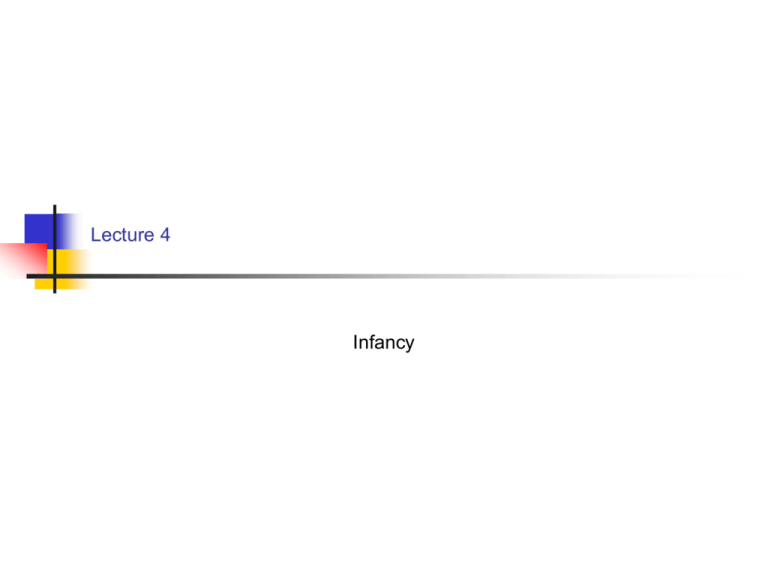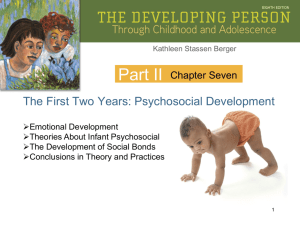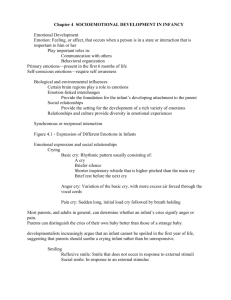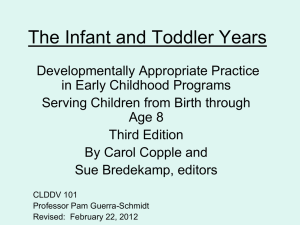Document
advertisement

Lecture 4 Infancy Reflexes They are automatic and beyond the newborn’s control; built-in reactions to stimuli. In these reflexes, infants have responses to their environment before they’ve had the opportunity to learn. Survival reflexes Example: The Sucking Reflex Occurs when newborns automatically suck an object placed in their mouth. Adaptive value: Enables newborns to get nourishment. Present at birth; later disappears at 3-4 months. Survival reflexes Example: The Rooting Reflex The rooting reflex occurs when the infant’s cheek is stroked or the side of the mouth is touched. In response, the infant turns its head toward the side that was touched in an apparent effort to find something to suck. The rooting reflex disappears when the infant is 3-4 months old, as it is replaced by the infant’s voluntary eating. Primitive reflexes Remnants of our evolutionary history? Example: The Moro reflex is a neonatal startle response that occurs in response to a sudden, intense noise or movement. When startled, a newborn arches its back, throws back its head, and flings out its arms and legs. The newborn then rapidly closes its arms and legs to the center of its body. Tends to disappear around 3-4 months of age. Primitive reflexes Example: The Grasping Reflex Occurs when something touches the infant’s palms. Infant responds by grasping tightly. Replaced around the end of the third month by voluntary grasps. A Classification Scheme for Infant States No REM sleep Active sleep without REM REM sleep Indeterminate sleep Drowsy Inactive alert Active awake Crying Sleep Newborns sleep 16-17 hours a day with individual variations. Most 1-month-olds begin sleeping longer at night. Researchers have found cultural variations in infant sleeping patterns. REM (Rapid Eye Movement) Sleep A recurring sleep stage during which vivid dreams commonly occur. Most adults spend about one-fifth of their night in REM sleep. Newborns spend about one-half of their sleep in REM sleep and it begins their sleep cycle. By 3 months the percentage of REM sleep falls to 40%, and it no longer starts their sleep cycle. REM sleep is thought to promote the brain’s development in infancy. Crying Crying is the most important mechanism newborns have for communicating with their world. Babies have at least three types of cries: The hunger cry. The anger cry. The pain cry. Responding to Infant Cries Most parents can determine whether an infant’s cries signify hunger, anger or pain. Parents can distinguish the cries of their own baby better than those of a strange baby. There exists controversy as to whether parents should respond to an infant’s cries or not. Consensus: Parents should soothe a crying infant rather than be unresponsive. Infants will thus develop a sense of trust and secure attachment to the caregiver. Motor development Growth is highly canalized Interindividual variations can be quite large Intraindividual development is uneven The average North American newborn is 51 cm long. Infants grow about 2.5 cm per month during the first year. Infants’ rate of growth is considerably slower in the second year of life. Gross Motor Skills Gross motor skills involve large muscle activities, such as moving one’s arms and walking. The actual month at which gross motor milestones occur varies by as much as 2 to 4 months. The sequence of accomplishments is quite uniform. Gross Motor Milestones 3-4 months - roll over 6 months - sit without support 12-13 months - walk without assistance 13-18 months - climb some steps 18-24 months - walk quickly, run stiffly, kick, jump Sensation and Perception Sensation occurs when information interacts with sensory receptors— the eyes, ears, tongue, nostrils, and skin. Perception is the interpretation of what is sensed. Nativists - Empiricists - Interactionists Methods (a) Preference Method In 1963 Robert Fantz discovered that infants look at different things for different lengths of time. He found that infants preferred to look at patterns rather than at color or brightness. Fantz also found that 2-day-old infants look longer at patterned stimuli than at single-colored discs. Methods (b) Habituation Method Habituation is the process by which infants become uninterested in a stimulus and respond less to it after it is repeatedly presented to them. Habituation can be used to tell us much about infants’ perception, such as the extent to which they can see, hear, smell, taste, and experience touch. Visual Acuity and Color The newborn’s acuity is limited. By the first birthday, the infant’s vision approximates that of an adult. At birth, babies can distinguish green and red. Hearing In the last few months of pregnancy, a fetus can hear sounds (the mother’s voice, music, etc.) Infants can hear immediately after birth, but a sound must be louder to be heard by a newborn than an adult. Infants are responsive to speech Touch and Pain Newborns respond to touch -> reflex. It used to be believed that newborns were impervious to pain, but it is now known that it is not true. Smell and Taste Newborns can differentiate odors. They appear to like vanilla and strawberry scents, but not those of rotten eggs and fish. Two-hour-old newborns made different facial expressions when they tasted sweet, sour, and bitter solutions. At 4 months of age, infants prefer salty tastes, which newborns found aversive. Depth Perception Gibson and Walk conducted the classic “visual cliff” experiment in 1960 to assess how early infants could perceive depth. They placed a piece of glass over a drop-off patterned the same as the table next to it. Mothers asked their infants from across the “cliff” to see if they would crawl on the glass over the drop-off. Most infants would not crawl out onto the glass, choosing instead to remain on the shallow side—indicating they could perceive depth. Problems with drawing a conclusions. Langlois, J. H., Roggman, L. A., & Rieser-Danner, L. A. (1990) Infants' differential social responses to attractive and unattractive faces. Developmental Psychology. 26,153-159. Two studies were conducted to examine infants' social responses to attractive and unattractive faces. In Study 1, 60 12-month-olds interacted with a stranger who wore a professionally constructed attractive or unattractive mask. The infants showed more positive affective tone, less withdrawal, and more play involvement with the stranger in the attractive condition. In Study 2, 43 12-month-olds played with an attractive and an unattractive doll. The infants played significantly longer with the attractive doll. These results extend and amplify earlier findings showing that young infants exhibit visual preferences for attractive over unattractive faces. Both visual and behavioral preferences for attractiveness are evidently exhibited much earlier in life than was previously supposed. Piaget’s Theory of Infant Cognitive Development Piaget believed that the child passes through a series of stages of thought from infancy to adolescence. The Stage of Sensorimotor Development According to Piaget, this stage lasts from birth to about 2 years of age. Mental development: Progression in the infant’s ability to organize and coordinate sensations with physical movements and actions. Children progress from having little more than reflexive patterns to work with to complex sensorimotor patterns and a primitive system of symbols. • 1. Modification of Reflexes Stage corresponds to the first month after birth. The basic means of coordinating sensation and action is through reflexive behaviors. 2. Primary Circular Reactions This stage develops between 1-4 months of age. A primary circular reaction is a scheme based on the infant’s attempt to reproduce an interesting or pleasurable event that initially occurred by chance. 3. Secondary Circular Reactions This stage develops between 4-8 months of age. The infant becomes more object-oriented or focused on the world, moving beyond preoccupation with the self in sensorimotor interactions. 4. Coordination of Secondary Circular Reactions This stage develops between 8-12 months of age. Intentionality. Infants readily combine and recombine previously learned schemes in a coordinated way. Actions are even more outwardly directed. 5. Tertiary Circular Reactions. This stage develops between 12-18 months of age. Tertiary circular reactions are schemes in which the infant purposely explores new possibilities with objects, continually changing what is done to them and exploring the results. Piaget believed this marks the developmental starting point for curiosity and interest in novelty. 6. Internalization of Schemes This stage develops between 18-24 months. The infant’s mental functioning shifts from a purely sensorimotor plane to a symbolic plane. The infant develops the ability to use symbols (internalized sensory images or words that represent events). Object Permanence Object permanence is the Piagetian term for understanding that objects and events continue to exist, even when they cannot directly be seen, heard, or touched. Imitation Andrew Meltzoff believes infants’ imitative abilities to be biologically based because they can imitate a facial expression within the first few days after birth. Language Development Phonology Semantics Syntax Pragmatics During much of the infant's first year the emphasis is on phonological development. How Language Develops Newborns: Preference for human voice. 6-8 weeks - cooing. 6-9 months - babbling begins (goo-goo). 10-15 months - the infant utters his/her first word The First Words The holophrase hypothesis states that a single word can be used to imply a complete sentence, and that infants’ first words characteristically are holophrastic. The One-Word Stage From about twelve to twenty months of age, most children speak only one word at a time. From about age eighteen months onward: vocabulary spurt. Errors: underextension and overextension. Language comprehension exceeds language production. Children show significant individual differences in the rates of language production. The Two-Word Stage At 18-24 months, children begin to utter two-word statements. Telegraphic speech is the use of short and precise words to communicate. Young children’s two- and three-word utterances are characteristically telegraphic. Biological Prewiring Linguist Noam Chomsky believes humans are biologically prewired to learn language at a certain time, in a certain way. He states children are born with a language acquisition device (LAD)—a biological endowment that enables them to detect certain language categories, such as phonology, syntax, and semantics. Behavioral and Environmental Influences Behaviorists view language as just another behavior involving chains of responses or imitation. We do not learn language in a social vacuum; most children are bathed in language from a very early age. Defining and Classifying Temperament Temperament is an individual’s behavioral style and characteristic way of emotional response. Many scholars conceive of temperament as a stable characteristic of newborns, which comes to be shaped and modified by later experiences. Temperament Classifications of Chess and Thomas Psychiatrists Alexander Chess and Stella Thomas believe there are three basic types of temperament. An easy child is generally in a positive mood, quickly establishes regular routines in infancy, and adapts easily to new experiences. A difficult child tends to react negatively and cry frequently, engages in irregular daily routines, and is slow to accept new experiences. A slow-to-warm-up child has a low activity level, is somewhat negative, shows low adaptability, and displays a low intensity of mood. Parenting and the Child’s Temperament Parents often don’t discover the importance of temperament until the birth of their second child. Management strategies that worked with the first child might not be as effective with the second child, and new problems might arise. Parents need to be sensitive and flexible. The “Difficult Child” Some books and programs for parents focus specifically on temperament, particularly “difficult” temperaments. There is a problem, however, identifying a child as “difficult” implying that the problem rests solely with him or her, rather than being on the particular “fit” between characteristics and environment. What Is Attachment? Attachment is a close emotional bond between the infant and the caregiver. Harlow and Zimmerman study found that feeding is not the crucial element in the attachment process and that contact comfort is very important. John Bowlby believes that the newborn is biologically equipped to elicit the attachment behavior from the primary caregiver. The Development of Attachment Phase 1: Birth to 2 months - Infants instinctively direct their attachment to human figures. Phase 2: 2-7 months - Attachment becomes focused on one figure, usually a primary caregiver. Phase 3: 7-24 months - Specific attachments develop. Phase 4: 24 months on - A goal-directed partnership is formed in which children become aware of others’ feelings, goals, and plans. Studying Attachment Mary Ainsworth believes that some babies have a more positive attachment experience than others. She created the Strange Situation—an observational measure of infant attachment that requires the infant to move through a series of introductions, separations, and reunions with the caregiver and an adult stranger in a prescribed order. Individual Differences Secure babies use their caregiver as a secure base from which to explore the environment. Insecure avoidant babies show insecurity by avoiding their caregiver. Insecure resistant babies may cling to the caregiver then resist her by fighting against the closeness, by kicking or pushing away. Disorganized babies are disorganized and disoriented, appearing dazed, confused, and fearful. Caregiving Styles and Attachment Classification Caregivers of securely attached babies are sensitive to their signals and are consistently available to respond to their infants’ needs. Caregivers of avoidant babies tend to be unavailable or rejecting, tending not to respond to their babies’ signals and having little physical contact with them. Caregivers of resistant babies sometimes respond to their babies’ need and sometimes do not. Caregivers of disorganized babies often neglect or physically abuse their babies, and sometimes these caregivers suffer from depression. Day Care The type of day care that young children receive varies extensively. Quality of care is typically based on group size, child-adult ratio, physical environment, caregiver characteristics, and caregiver behavior. Findings of Day Care Research It has been discovered that children in low-quality day care as infants were least likely to be socially competent in early childhood. Children who come from families with few resources are more likely to experience poor-quality day care than more advantaged children. High-quality child care, especially sensitive and responsive attention, was linked with fewer child problems.






